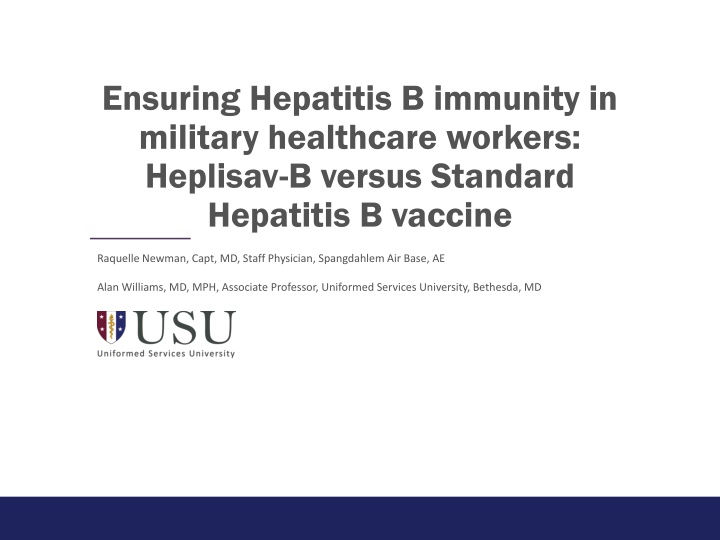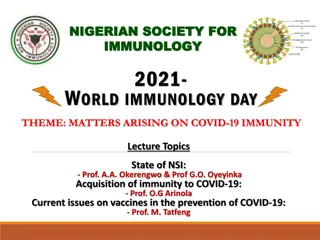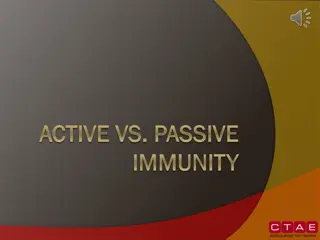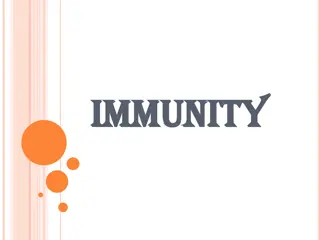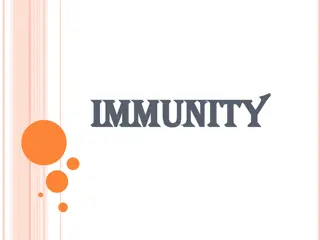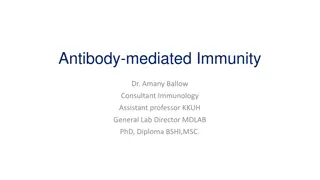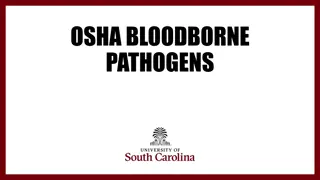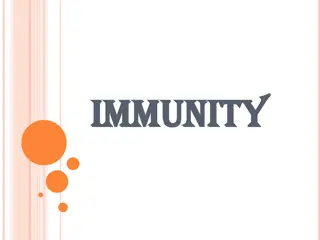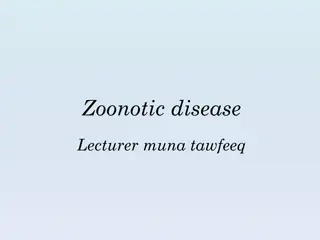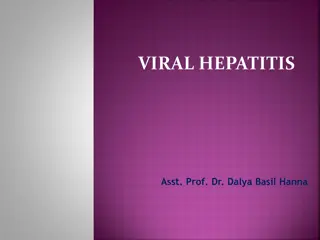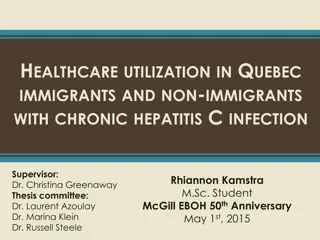Ensuring Hepatitis B Immunity in Military Healthcare Workers: Heplisav-B vs. Standard Vaccine
Hepatitis B is a vaccine-preventable liver infection caused by the HBV. This study compares Heplisav-B and standard vaccines to ensure immunity in military healthcare workers. Learn about the background, new HBV vaccines, and medical decisions based on exposure risk. Explore the clinical scenario of a new healthcare worker with a low antibody level and the options available to improve immunity.
Download Presentation

Please find below an Image/Link to download the presentation.
The content on the website is provided AS IS for your information and personal use only. It may not be sold, licensed, or shared on other websites without obtaining consent from the author.If you encounter any issues during the download, it is possible that the publisher has removed the file from their server.
You are allowed to download the files provided on this website for personal or commercial use, subject to the condition that they are used lawfully. All files are the property of their respective owners.
The content on the website is provided AS IS for your information and personal use only. It may not be sold, licensed, or shared on other websites without obtaining consent from the author.
E N D
Presentation Transcript
Ensuring Hepatitis B immunity in military healthcare workers: Heplisav-B versus Standard Hepatitis B vaccine Raquelle Newman, Capt, MD, Staff Physician, Spangdahlem Air Base, AE Alan Williams, MD, MPH, Associate Professor, Uniformed Services University, Bethesda, MD
Disclosure The views and statements in the presentation are solely from the investigators. They do not represent the opinions or positions of the Uniformed Services University of the Health Sciences or the Department of Defense. The investigators have no financial disclosures. 2
Background Hepatitis B is vaccine-preventable infection of the liver caused by the hepatitis B virus (HBV). Transmission occurs through exposure to infected blood or other body fluids. 3
Background New HBV infections have declined since hepatitis B vaccination became available in 1980s (Recombivax, Energix, Twinrix). The standard series for hepatitis B vaccination is a 3 dose schedule 0, 1, and 6 months. Infant vaccination to prevent hepatitis B is the standard of care and most infants receive their first dose in the hospital after birth. In 2017, the new adjuvanted Heplisav-B vaccination was approved for non-pregnant individuals over age 18 as a 2 dose series. 4
Background Medical decisions regarding hepatitis B immunity are based on risk of exposure Average risk General population Hepatitis B vaccine - recommended Lab titer - not recommended Increased risk Service members and others Hepatitis B vaccine OR lab titer 5
Background Highest risk Healthcare workers (high confidence in durable immunity desired) Full hepatitis B vaccine AND a (one-time) positive titer In the United States, immunity against HBV after vaccination defined as positive hepatitis B surface antigen antibodies (anti-HBs) >10 mIU/mL Anti-HBS titer declines over time, though protection from clinically significant infection persists 6
Introduction CLINICAL SCENARIO New healthcare worker with a vaccine record of a full series, no prior labs and a hepatitis B surface antibody <10 mIU/ml. We cannot distinguish between a prior responder and a nonresponder. Options: Repeat full series Booster and titer Standard Hep B vaccine (Recombivax, Energix, Twinrix) Heplisav-B 7
Objectives Is a single booster followed by a titer an effective strategy for confirming immunity in a previously vaccinated individual with a below threshold titer? Is there a difference between the standard hepatitis B vaccination compared to the newer adjuvanted vaccine (Heplisav-B) as a booster dose in previously vaccinated individuals? 8
Methods Design: Observational cohort study Study Population: 693 medical student matriculants (2019-2022) IRB approval/DHA data sharing agreement Data Gathering: Individual chart review by co-investigators collecting only hep B vaccine and anti-HBs data. 9
Data Flow Chart All subjects (n = 693) No Evidence of immunity (n = 350) Did the subject have any prior labs showing hepatitis B immunity? Yes (n = 343) 10
Data Flow Chart Data Flow Chart 2. Full vaccine series? Does the subject have documentation of a full hepatitis B vaccine series? No Will need to complete full series (n = 86) Yes (n = 257) 11 11
Data Flow Chart 3. Titer after single booster? Did the potentially susceptible subject have a single booster dose followed by a titer? No More than single booster dose (n = 15) Yes (n = 242) 12
Data Flow Chart Subjects with a prior complete Hep B vaccine series and a Hep B surface antibody titer below 10 mIU/mL who received a single dose of booster followed by a titer (n = 242) Standard hepatitis B booster (n = 82) Heplisav-B booster (n = 160) 13
All subjects (n = 693) Evidence of immunity (n=350) No 1. Quantitative titer <10 mIU/ml? Yes Will need to complete full series (n=86) No 2. Full Hep B vaccine series? Yes More than single dose booster (n=15) No 3. Titer after a single booster? Yes Complete Hep B vaccine series and a Hep B surface antibody titer < 10 mIU/ml who received a single dose of booster followed by a titer (n=242) Heplisav-B booster (n=160) Standard hepatitis B booster (n=82)
Results Elapsed time between completion of initial Hep B vaccine series and titer All subjects Standard Vaccine Booster Heplisav-B Booster Sample size n= 82 n=160 Average interval 21.5 years 21.1 years Standard deviation 4.7 years 4.2 years t-statistic 0.683, p=0.4955 15
Results Response rate to single booster dose of Hepatitis B vaccine in previously vaccinated* military medical students *All subjects received 3 or 4 doses of standard hepatitis B prior to their titer Standard Vaccine Booster Heplisav-B Booster Sample size n= 82 n=160 anti-HBs > 10 mIU/ml 76 159 anti-HBs < 10 mIU/ml 6 1 Percent immune 92.7% 99.4% Percent difference 6.7% difference Chi-Squared comparison of proportions (95% CI 1.9%-14.5%) p=0.0032 16
Discussion High response rate to a single Hep B booster in study population. Single booster with Heplisav-B is more effective. Cost considerations: Heplisav-B ($74.94) vs standard hepatitis B vaccination ($34.32) Lab cost for anti-HBs (Varies by location, as low as $3) Using Heplisav-B would require fewer visits 17
Limitations Military subjects may not generalizable to general population De-identified data Unable to correlate how certain demographics may influence immune response Did not differentiate between the three standard hepatitis B vaccines 18
Conclusion For military healthcare workers who have a complete series and a titer below 10 mIU/ml, a single dose of hepatitis B vaccine is highly likely to result in confirmed immunity. Heplisav-B is somewhat more likely to result in confirmed immunity with a single dose (99.4% vs 92.7%) when compared to standard hepatitis B vaccines. 19
References 1. Pinkbook: hepatitis b | cdc. Published September 22, 2022. Accessed December 22, 2023. https://www.cdc.gov/vaccines/pubs/pinkbook/hepb.html 2. 2021 hepatitis b | viral hepatitis surveillance report | cdc. Published August 7, 2023. Accessed December 22, 2023. https://www.cdc.gov/hepatitis/statistics/2021surveillance/hepatitis-b.htm 3. Brasel KJ, Mol C, Kolker A, Weigelt JA. Needlesticks and surgical residents: who is most at risk? Journal of Surgical Education. 2007;64(6):395-398. doi:10.1016/j.jsurg.2007.04.003 4. Zbeidy R, Livingstone J, Shatz V, et al. Occurrence and outcome of blood-contaminated percutaneous injuries among anesthesia practitioners: a cross-sectional study. International Journal for Quality in Health Care. 2022;34(1):mzac019. doi:10.1093/intqhc/mzac019 5. Schillie S, Harris A, Link-Gelles R, Romero J, Ward J, Nelson N. Recommendations of the advisory committee on immunization practices for use of a hepatitis b vaccine with a novel adjuvant. MMWR Morb Mortal Wkly Rep. 2018;67(15):455-458. doi:10.15585/mmwr.mm6715a5 6. Williams AL. Heplisav-b in prior hepatitis b vaccine nonresponders: a case series. Mil Med. 2022;187(7- 8):e811-e813. doi:10.1093/milmed/usab397 7. Schillie S, Vellozzi C, Reingold A, et al. Prevention of hepatitis b virus infection in the united states: recommendations of the advisory committee on immunization practices. MMWR Recomm Rep. 2018;67(1):1-31. doi:10.15585/mmwr.rr6701a1 8. BUMEDINST 6230.15B; AFI 48-110_IP; CG COMDTINST M6230.4G. Immunizations and Chemoprophylaxis for the Prevention of Infectious Diseases. Published online October 7, 2013. 20
References 9. Blumberg EA. Mmwr: cdc guidance for evaluating healthcare personnel for hepatitis b virus protection and for administering postexposure management. American Journal of Transplantation. 2014;14(3):729- 731. doi:10.1111/ajt.12688 10. For healthcare personnel archives. Immunize.org. Published July 21, 2023. Accessed December 22, 2023. https://www.immunize.org/ask-experts/topic/hepb/healthcare-personnel/ 11. Bruce MG, Bruden D, Hurlburt D, et al. Antibody levels and protection after hepatitis b vaccine: results of a 30-year follow-up study and response to a booster dose. J Infect Dis. 2016;214(1):16-22. doi:10.1093/infdis/jiv748 12. F. Edward H bert School of Medicine Office of Admissions. Class of 2023 Fact Sheet. Published online August 1, 2019. 13. F. Edward H bert School of Medicine Office of Admissions. Class of 2024 Fact Sheet. Published online July 29, 2020. 14. F. Edward H bert School of Medicine Office of Admissions. Class of 2025 Fact Sheet. Published online June 30, 2021. 15. F. Edward H bert School of Medicine Office of Admissions. Class of 2026 Fact Sheet. Published online July 21, 2022. 16. Vfc | current cdc vaccine price list | cdc. Published December 15, 2023. Accessed December 22, 2023. https://www.cdc.gov/vaccines/programs/vfc/awardees/vaccine-management/price-list/index.html 21
Questions 22
Results Aggregate demographics* Overall population characteristics Age range 20-43 years Average age 25 years Gender Male 51.6% Female 48.4% Race/Ethnicity 65% Caucasian, 18% Asian, 9% Hispanic, 6% Black *Source: USUHS SOM Office of Admissions 23
24 https://www.cdc.gov/mmwr/preview/mmwrhtml/rr6210a1.htm
